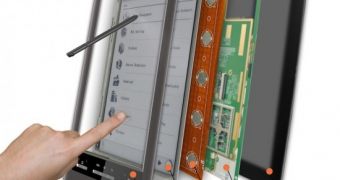It appears that Hanvon has come up with a new technology that might just revolutionize the way touchscreens track fingers and styluses, to the point where it is likely that it won't be long before actual slates and the like adopt it.
Nowadays, touch support is showing up practically everywhere, but providing stylus support, especially for panels mostly focused on finger recognitions, can be a bit tricky.
Apparently, Hanvon decided it was high time an affordable solution existed that gave a touch panel the ability to alternate automatically between pen and finger input.
More specifically, while active digitizers and the like can be used to give a screen support for both, they aren't the most affordable of inventions.
As such, Hanvon decided to use its ERT (electromagnetic resonance technology) to build a so-called “dual-touch” system.
Basically, when the panel detects a stylus in close proximity, it completely shuts down finger/hand-touch response.
This gives high input accuracy (0.1mm) and makes the issue of phantom-presses, among other things, gone.
The other major advantage is that it is between 30% and 50% cheaper than capacitive touchscreens, not to mention easier to implement, since all it takes is an antenna array over the sensor board.
The data report rate is of 200 dots per second and the control doesn't have to be thicker than 0.8mm (under 2mm for the board).
All in all, coupled with the 100% transmittance, the “dual-touch” system enables cheaper, thinner touch slates with intelligent input. Tablets and e-readers should both benefit from it (eventually).
“With the increasing adoption of mobile, eReader and tablet products, touch screens have become the primary user interface,” said Liu Yingjian, president of Hanvon.
“Consumers should be able to interact with their devices quickly and accurately and manufacturers should be able to meet those demands at a reasonable cost. Hanvon’s Dual-Touch ERT Technology is the first finger touch plus ERT in the market to deliver this experience to both consumers and manufacturers.”

 14 DAY TRIAL //
14 DAY TRIAL //